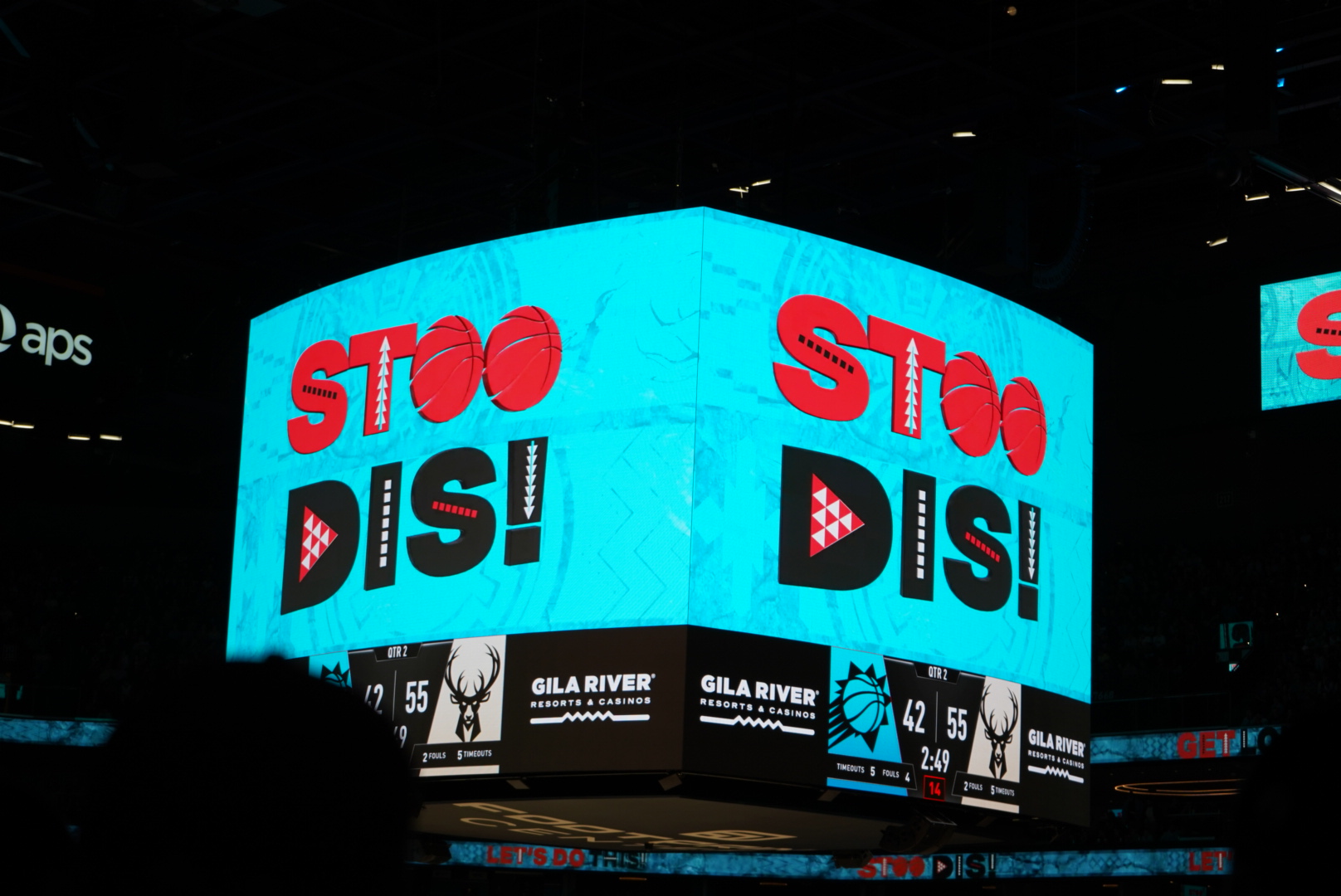
- Details
- By Darren Thompson
On April 4, the team hosted its 10th and final ORIGINATIV night of the season during a game against the San Antonio Spurs, its 65th consecutive sold-out game to a crowd of 17,071.
ORIGINATIV night showcases an all-out Native theme from the entrance, signage, special recognitions, music and entertainment — both for the National Anthem and the halftime performances. Additionally, during ORIGINATIV nights, the Suns play in their City Edition uniforms — a collaboration between the NBA and sports-wear giant Nike to showcase the unique heritage of NBA teams’ home city — on a court designed to pay recognition to all 22 federally recognized tribes in Arizona.
“From the streets to the seats, they get a little taste of the Rez,” said Phoenix Suns Director of Live Entertainment Shawn Martinez in an interview with Native News Online. “We wanted to give hope to Native American youth, not only in Arizona but across the country.”
Not only were all of Arizona’s Tribes recognized at each game, but they had a voice in the programming.
“We listened to all of the leaders in the community,” Martinez said. “...It was a labor of love, and it came straight from the heart of the people.”
ORIGNATIVE was initially pitched by the Suns’ Senior Director of Marketing, Graham Wincott. It was brought to life through collaboration with Nike N7 and various Arizona tribes and prominent Native organizations — such as the Gia River Indian Community, United National Indian Tribal Youth Phoenix Indian Center, the Native American Basketball Invitation and more.
The ORIGINATIV April 4 finale also made history by being the first sports game broadcast in two Indigenous languages: Apache and Diné. The game was aired by tribal radio stations KWKM, based on the San Carlos Apache Reservation, and KTNN, the official radio station of the Navajo Nation.
“I think our Phoenix Suns organization and players really respected what was featured,” Navajo Sportscaster L.A. Williams told Native News Online. “You could see the vibes of how much it meant to them. Feeling the floor, the jerseys they were wearing, looking around and seeing all of the Native American people from not only Arizona but nationwide to see the closeout of the ORIGINATIV.”
Williams has more than 30 years of sportscasting in the Navajo/Dine language. Last season, Williams broadcasted the Suns’ playoffs games for the first time.
Martinez says ORIGINATIV has caught the attention of other NBA teams, noting that the Charlotte Hornets attended the final game to see it for themselves.
There may be more tribal recognition on the horizon for the NBA — potentially a celebration of Native American Heritage Month in which all players would potentially wear a shooting shirt that features Native American designs during November, Martinez said.
“Hopefully, that can happen,” Martinez said. “But it’s a start of what can happen.”
More Stories Like This
New Book Showcases 250 Images by Indigenous Photographers Spanning Two CenturiesFive Native American Chefs You Should Know
Short Film Documents First Full Kayak Run of the Klamath After Dam Removals
Joy Harjo Honored With Portrait of a Nation Award at Smithsonian Gala
Creative Continuities: Family, Pride, and Community in Native Art Opens Today at the Autry Museum in LA
Help us tell the stories that could save Native languages and food traditions
At a critical moment for Indian Country, Native News Online is embarking on our most ambitious reporting project yet: "Cultivating Culture," a three-year investigation into two forces shaping Native community survival—food sovereignty and language revitalization.
The devastating impact of COVID-19 accelerated the loss of Native elders and with them, irreplaceable cultural knowledge. Yet across tribal communities, innovative leaders are fighting back, reclaiming traditional food systems and breathing new life into Native languages. These aren't just cultural preservation efforts—they're powerful pathways to community health, healing, and resilience.
Our dedicated reporting team will spend three years documenting these stories through on-the-ground reporting in 18 tribal communities, producing over 200 in-depth stories, 18 podcast episodes, and multimedia content that amplifies Indigenous voices. We'll show policymakers, funders, and allies how cultural restoration directly impacts physical and mental wellness while celebrating successful models of sovereignty and self-determination.
This isn't corporate media parachuting into Indian Country for a quick story. This is sustained, relationship-based journalism by Native reporters who understand these communities. It's "Warrior Journalism"—fearless reporting that serves the 5.5 million readers who depend on us for news that mainstream media often ignores.
We need your help right now. While we've secured partial funding, we're still $450,000 short of our three-year budget. Our immediate goal is $25,000 this month to keep this critical work moving forward—funding reporter salaries, travel to remote communities, photography, and the deep reporting these stories deserve.
Every dollar directly supports Indigenous journalists telling Indigenous stories. Whether it's $5 or $50, your contribution ensures these vital narratives of resilience, innovation, and hope don't disappear into silence.
 The stakes couldn't be higher. Native languages are being lost at an alarming rate. Food insecurity plagues many tribal communities. But solutions are emerging, and these stories need to be told.
The stakes couldn't be higher. Native languages are being lost at an alarming rate. Food insecurity plagues many tribal communities. But solutions are emerging, and these stories need to be told.
Support independent Native journalism. Fund the stories that matter.
Levi Rickert (Potawatomi), Editor & Publisher
